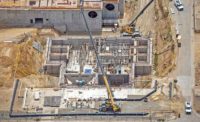As a key design consultant for a state that recently passed a $5.3-billion transportation package, Portland-based David Evans and Associates Inc. helps keep Oregon moving. DEA’s work for the state Dept. of Transportation includes the planned $30-million widening of Interstate 205 in the Portland area, a project so fast-paced that some consultants shied away from pursuing it.
“They felt the accountability aspect of it was more risk than they wanted to take on,” says Mike Baker, DEA vice president and Oregon region transportation business development leader.
Founded in 1976, DEA specializes in the design and management of complex transportation, land development, water resources, environmental and energy projects. The firm has 26 locations and more than 1,000 employees nationwide, helping it reap $150 million in revenue in 2016.
“Business is good right now,” says Al Barkouli, DEA chairman and CEO. “In the past year, we’ve seen more investments in public infrastructure and a rebound in housing and private sector development work.” Along with low unemployment, he says, these factors have “fueled a lot of opportunities.”
In Oregon and Washington, DEA is working on 61 large projects, each exceeding $1 million. These projects have a combined worth of more than $250 million.
One of DEA’s hottest markets is transportation and transit-oriented development, strengthened by Oregon’s $5.3-billion transportation package approved in July.
In Oregon, “we are largely a transportation-focused enterprise,” Baker says. About 60% of DEA’s work in the region is in transportation planning, design and construction engineering services.
“Our presence spans all of those areas, so we are able to follow projects from initial concept through planning and construction support, working with owners and contractors,” Baker says. “It’s nice to watch the entire life cycle of a project and be able to actively participate in all steps.”
Lighting a ‘Quick Fuse’
As the prime consultant on the I-205 project, DEA’s responsibilities include preparing contract documents as well as structural, roadway and traffic engineering and water resources engineering. The project is about 10% into preliminary engineering and should break ground in 2019.
Ed Chamberland, DEA project manager for I-205, notes the project’s aggressive schedule. When the state recently passed House Bill 2017, it designated I-205 a “trigger” project, meaning it must be completed by a certain date to receive funding and for more gas taxes to be triggered to raise additional transportation dollars.
“It has a real quick fuse and has to be built by October of 2019,” says Chamberland, who is also DEA’s Oregon region roads and highways manager. “This is basically going to take a year for design and a year for construction. Normally, this would be a three- to four-year project. So the biggest challenge is the schedule being accelerated greatly.”
One of the firm’s team members is DKS Associates, which is responsible for most of the traffic engineering. Nate Schroeder, Portland design group manager for DKS and traffic engineering lead on I-205, says the rapid schedule is creating challenges in terms of coordination and getting everybody on the same page.
“DEA is very organized and proactive and easy to communicate with,” says Schroeder. “They don’t necessarily dictate to the team; they engage us in terms of things that affect schedule and our budget and our scope. They are very conscious of their subconsultants and how changes they may make would impact us and our ability to do things. And this is definitely appreciated.”
Stormwater at Ten Trails
DEA is also working on the $1.5-billion Ten Trails master-planned community in Black Diamond, Wash. Covering 1,200 acres, the project has an entitlement for 6,000 homes and 1.5 million sq ft of commercial buildings in addition to 500 acres of public space. The project broke ground last year and has a 15-year build-out.
On this project, DEA’s land development unit is providing engineering, surveying and landscape architecture and is helping coordinate other consultants around wetlands and sensitive areas with the project’s managing partner, Oakpointe Communities of Kirkland, Wash.
Soil and environmental conditions led DEA to build a stormwater facility, says Al Fure, DEA vice president in Woodinville, Wash. DEA also helped overcome a challenge of installing water lines on a 100-yr-old bridge on site, says Colin Lund, Oakpointe director of development. The team encased the stainless-steel water lines in lightweight concrete, which solved weight issues and improved structural integrity.
DEA’s deep understanding of the Ten Trails master plan made it a good fit for the project, Lund says. “We are having to think 15 years in the future for infrastructure we are putting in today, and the DEA team has a good handle on long-term infrastructure planning.”







Post a comment to this article
Report Abusive Comment